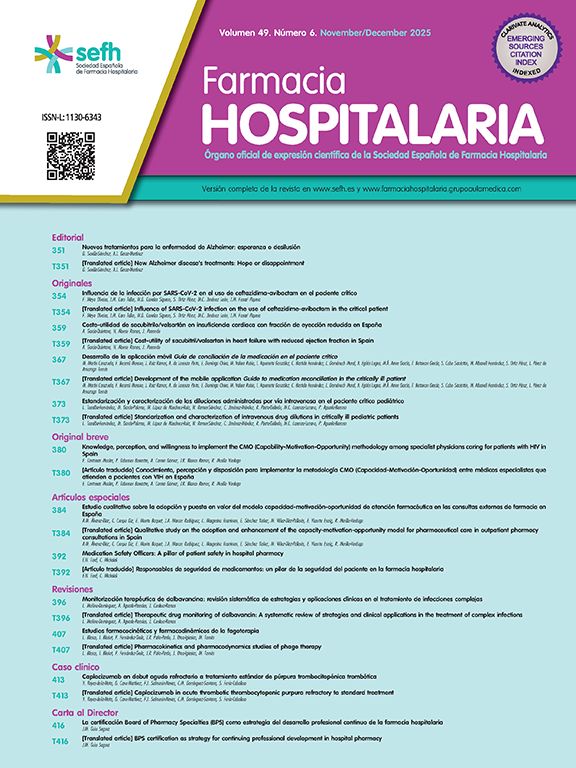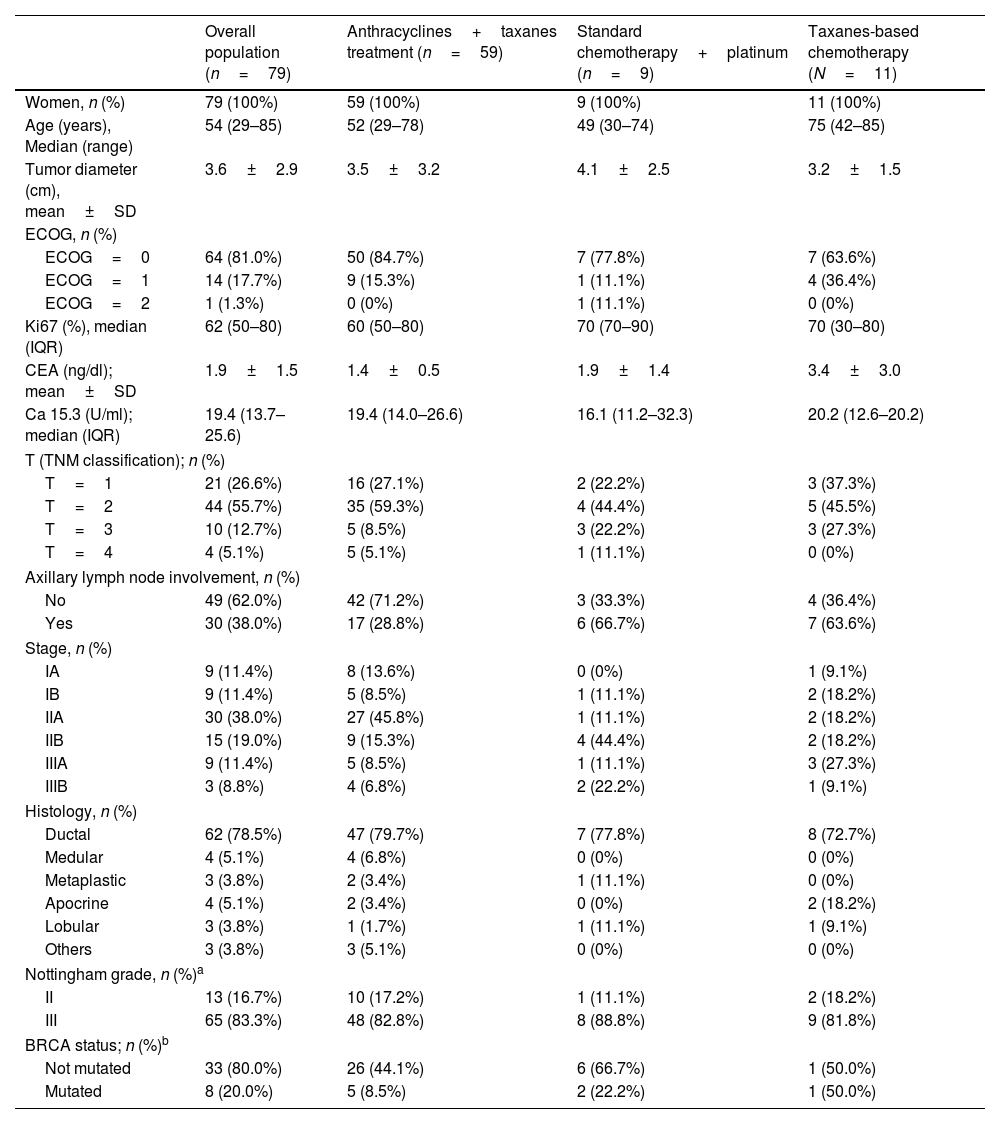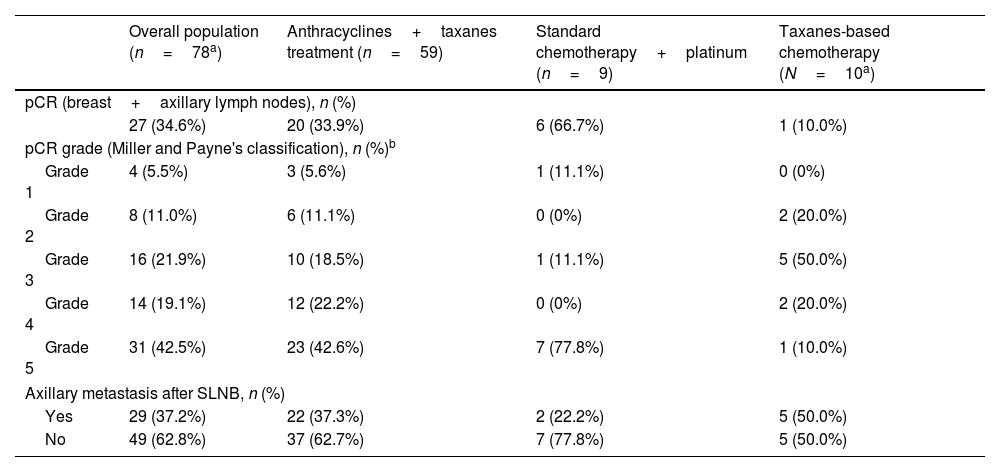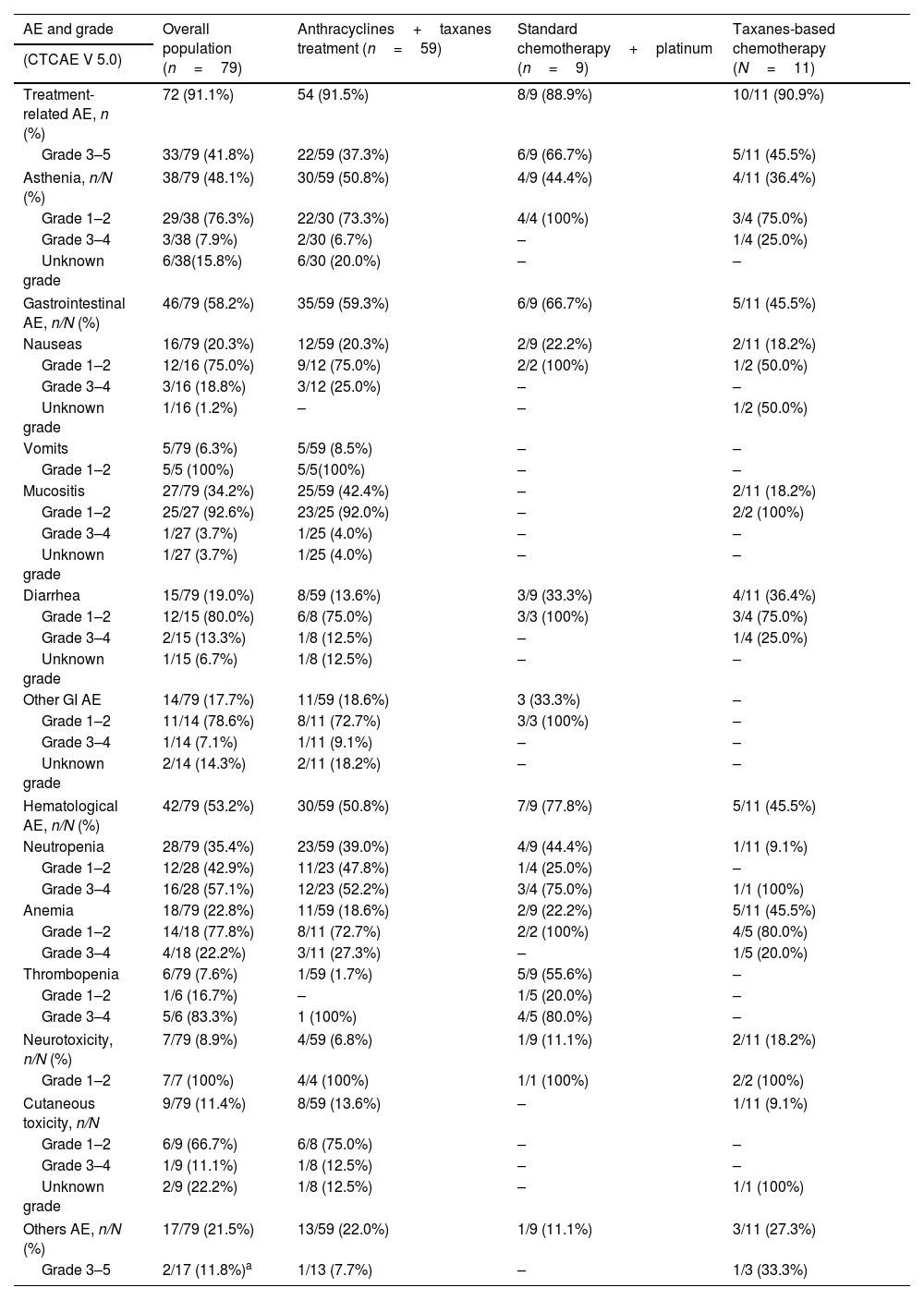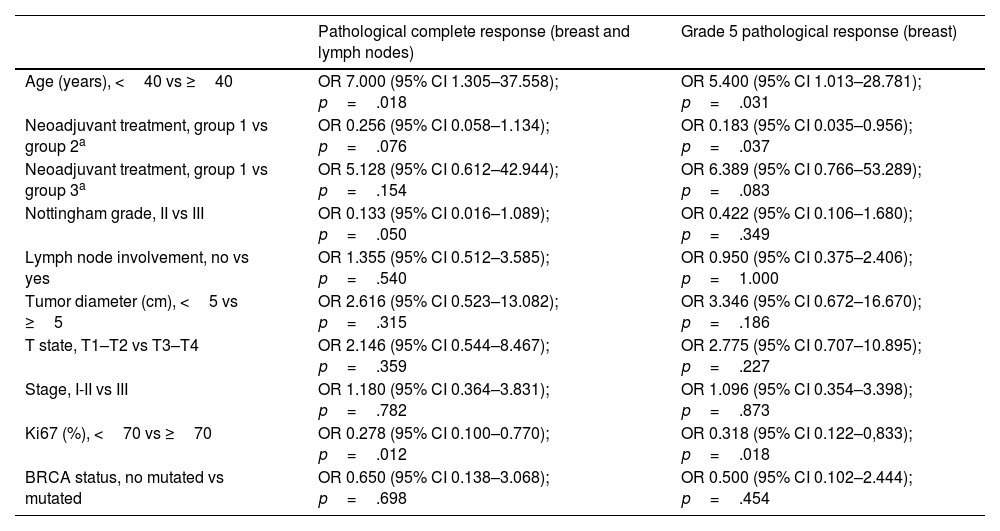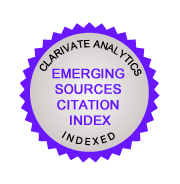Triple-negative breast cancer is a subtype of aggressive breast cancer. Our aim is to evaluate the effectiveness and safety of neoadjuvant treatment in early-stage triple-negative breast cancer and to identify predictors of pathological complete response.
MethodsThis is a single-center, retrospective study involving 79 patients with triple-negative breast cancer who initiated neoadjuvant treatment between January 2017 and October 2022. Descriptive analyses were performed as appropriate. Statistical analysis utilized bivariate logistic regression to explore the presence of factors related to pathological complete response, and the Kaplan–Meier method was employed for survival analysis.
ResultsIn the overall population, 27 patients (n=78; 34.6%) achieved pathological complete response in the breast and axillary lymph nodes, and 31 (n=73; 42.5%) achieved a grade 5 pathological complete response in the breast, according to the Miller and Payne classification. The addition of platinum to standard therapy improved both breast and axillary lymph node pathological complete response rates. Age less than 40 years was identified as a predictor of pathological complete response in our study population through bivariate analysis, while Ki67 levels lower than 70% were associated with a lower pathological complete response rate. Adverse events were reported in 72 patients (91.1%), with grade 3–5 adverse events observed in 33 (41.8%). There was a particularly notable increase in gastrointestinal and hematological adverse events when platinum was added.
ConclusionsIn this population, we observed moderate rates of pathological complete response with acceptable chemotherapy tolerance. Platinum-based chemotherapy appears to enhance the likelihood of achieving pathological complete response, albeit with a less favorable safety profile. Therefore, evaluating the benefit–risk balance is crucial when selecting the optimal chemotherapy regimen for individual patients.
El cáncer de mama triple negativo es un subtipo agresivo de cáncer de mama. Nuestro objetivo es evaluar la eficacia y seguridad del tratamiento neoadyuvante en el cáncer de mama triple negativo en etapas tempranas, y identificar predictores de la respuesta patológica completa.
MétodosEste es un estudio retrospectivo de un solo centro que incluye a 79 pacientes con cáncer de mama triple negativo que iniciaron tratamiento neoadyuvante entre enero de 2017 y octubre de 2022. Se realizaron análisis descriptivos según corresponda. El análisis estadístico utilizó la regresión logística bivariante para explorar la presencia de factores relacionados con la respuesta patológica completa, y se empleó el método de Kaplan–Meier para el análisis de supervivencia.
ResultadosEn la población general, 27 pacientes (n=78; 34.6%) alcanzaron respuesta patológica completa en la mama y los ganglios linfáticos axilares, y 31 (n=73; 42.5%) lograron una respuesta patológica completa de grado 5 en la mama, según la clasificación de Miller y Payne. La adición de platino al tratamiento estándar mejoró las tasas de respuesta patológica completa tanto en la mama como en los ganglios linfáticos axilares. La edad menor de 40 años fue identificada como un predictor de respuesta patológica completa en nuestra población de estudio mediante análisis bivariante, mientras que niveles de Ki67 inferiores al 70% se asociaron con una tasa de respuesta patológica completa más baja. Se informaron eventos adversos en 72 pacientes (91.1%), con eventos adversos de grado 3–5 observados en 33 (41.8%). Hubo un aumento notable en los eventos adversos gastrointestinales y hematológicos cuando se agregó platino.
ConclusionesEn esta población, observamos tasas moderadas de respuesta patológica completa con tolerancia aceptable a la quimioterapia. La quimioterapia basada en platino parece aumentar la probabilidad de lograr respuesta patológica completa, aunque con un perfil de seguridad menos favorable. Por lo tanto, evaluar el equilibrio entre beneficio y riesgo es crucial al seleccionar el régimen de quimioterapia óptimo para cada paciente individual.
Breast cancer is the most frequent neoplasm in women worldwide. In Europe, it is the most diagnosed type of cancer, with a 5-year prevalence of 2 138 117 patients (GLOBOCAN 2020).1 Triple-negative breast cancer (TNBC) accounts for approximately 15% of breast cancer diagnoses worldwide, representing almost 200 000 cases per year.2
TNBC is a tumor subtype characterized by a lack of expression of the hormone receptor and human epidermal growth factor receptor type 2 (HER2).2 This molecular subtype of breast cancer is associated with a worse prognosis compared to other subtypes.3
In most cases, breast cancer is diagnosed at localized stages and requires adjuvant or neoadjuvant chemotherapy treatment, both of which have similar efficacy in terms of disease-free survival (DFS) and overall survival (OS).4 Neoadjuvant therapy refers to systemic treatment of breast cancer prior to definitive surgical therapy and should begin as soon as diagnosis and staging is complete (ideally within 2–4 weeks).5 In TNBC, currently the worst prognostic subtype of breast cancer, neoadjuvant therapy plays an increasingly relevant role in early stage, giving the opportunity for local therapy and better long-term results in poor-prognosed patients.3 In addition, neoadjuvant therapy determines the response to chemotherapy and allows for a higher rate of breast-conserving surgery.4 This is especially important for patients with stage I–III TNBC with tumor diameters of more than 2 cm and/or positive nodes, the use of neoadjuvant therapy is expected to be of most benefit.6
In addition, several studies show that a pathological complete response (pCR) following neoadjuvant chemotherapy is a major prognostic marker.7 Obtaining a pCR, defined as the complete absence of neoplastic cells after treatment in the breast and axilla according to the residual cancer burden criteria proposed by Symmans (equivalent to a grade 5 response in the Miller and Payne anatomopathological classification), is therefore one of the main objectives of neoadjuvant treatment.8,9
Classical neoadjuvant chemotherapy regimens typically incorporate alkylating agents, taxanes, and anthracyclines, with pCR rates generally hovering around 34%.7 There is currently no direct evidence from randomized phase III clinical trials regarding the optimal neoadjuvant chemotherapy regimen for patients with TNBC. Treatment for TNBC tumors involves chemotherapy, with or without immune checkpoint inhibitors (ICIs) such as pembrolizumab.10,11 Neoadjuvant therapy is preferred for cT1c-4 N0 TNBC, with neoadjuvant chemotherapy including pembrolizumab recommended for cT2–4 N0 TNBC or stage II–III N-positive TNBC, unless there is a risk of immune toxicity. Chemotherapy regimens are similar between neoadjuvant and adjuvant, except for the use of pembrolizumab in the former for high-risk patients. Non-ICI regimens are sequential, based on anthracyclines (AC) such as doxorubicin/cyclophosphamide or epirubicin/cyclophosphamide (EC), followed by a taxane or taxane/carboplatin. In cases where anthracyclines are contraindicated, a non-anthracycline taxane-based regimen, such as docetaxel/cyclophosphamide or a taxane plus carboplatin, may be used.10 In high-risk patients, the incorporation of platinum into the standard neoadjuvant chemotherapy regimen, has consistently demonstrated an improvement in complete response rates by up to 20%.12,13 Platinum salts are transported into the tumor cell, bind to DNA, and cross-link within and between DNA strands to prevent replication. Platinum salts should be more effective in TNBC due to the more frequent DNA repair damage caused by germline mutations in tumor suppressor genes (BRCA1/2) or by somatic mutation leading to homologous recombination deficiency.9 Furthermore, recent evidence suggests that a dose-dense regimen with AC for classical chemotherapy schedules, along with the incorporation of immunotherapeutic agents like pembrolizumab, have a positive impact on long-term pCR rates.6,11
However, there are not currently recommendations about the profile of patients who obtain the maximum benefit from different treatments. Based on a personalized approach, the clinician needs to balance potential benefits and harms,9 leading to a choice of therapies based on an individual's risk of relapse, expected sensitivity to treatment, the benefit and toxicities of treatment, and the patient's biological age, general performance status, comorbidities, and patients' preferences.5
Therefore, the primary objective of this study is to evaluate the effectiveness of neoadjuvant treatment in early-stage TNBC, with a secondary goal of assessing safety and identifying potential predictors of pCR.
MethodsDesign and study populationThis is an observational, analytical, single-center, retrospective study. All patients with early-stage TNBC who had started neoadjuvant treatment between January 2017 and October 2022 were included. Patients with visceral or bone metastases at diagnosis were excluded. This study was approved by the Ethical Committee of the Health Management Area of South Seville and was conducted in accordance with the Declaration of Helsinki (as revised in 2013).
Baseline patient characteristics were collected, including age, tumor diameter, lymph node involvement, Ki67, performance status according to the Eastern Cooperative Oncology Group (ECOG), disease stage, TNM (T=tumor, N=node, and M=metastasis) status, histology, Nottingham histological grade, BRCA mutation, and Ca 15.3 levels. In addition, information on the neoadjuvant treatment received, surgery after neoadjuvant treatment (yes/no), the need for adjuvant chemotherapy and/or radiotherapy (yes/no) and the number of subsequent lines in the metastatic setting was collected. Three neoadjuvant chemotherapy regimens were evaluated, including anthracyclines+taxanes (EC+docetaxel/paclitaxel/nab-paclitaxel), standard chemotherapy+platinum (EC+paclitaxel/nab-paclitaxel-carboplatin or paclitaxel/nab-paclitaxel-carboplatin), and taxane-based chemotherapy (docetaxel as monotherapy or docetaxel-cyclophosphamide).
The primary endpoint of the study was pCR in breast and axilla. The breast pCR rate was determined following the Miller and Payne system9 and pCR rates regarding to neoadjuvant received treatment, OS, and DFS were also estimated. DFS was defined as the time from initiation of neoadjuvant treatment to detection of disease recurrence (clinical/radiological) or death by any cause. OS was defined as the time from diagnosis to death by any cause.
For the safety analysis, the occurrence of adverse events (AEs) of any grade and the occurrence of grade 3–4 AEs (according to the Common Terminology Criteria for Adverse Events (CTCAE) v. 5.0) were collected.14
As this was an observational, descriptive study, all patients who fulfilled inclusion criteria were included, with no formal sample size estimation. Data were gathered from electronic medical records up until the date of death, the date of the last healthcare contact (in case of loss of follow-up), or the predetermined cut-off date (May 31, 2023).
Statistical analysisDescriptive analyses were performed, with categorical variables described as frequency and percentages, and quantitative variables presented as median and interquartile range (IQR) or mean and standard deviation, as appropriate. Variables with missing data were handled by calculating the percentage of missing values relative to the total available dataset. The specific number of missing values for each variable is explicitly stated.
Survival analysis was carried out using the Kaplan–Meier method. Additionally, bivariate comparisons were performed to explore the presence of factors related to pCR, with an alpha level of 0.05 and statistical significance set at a p-value <.05. The analysis is restricted to a bivariate comparison due to the small sample size and disparities in sample sizes between groups, which precludes statistically reliable multivariate analyses. In instances of loss to follow-up, censoring was applied in the survival analysis using the Kaplan–Meier method, with the date of the last interaction with healthcare serving as the reference point. Data analysis was performed with the IBM SPSS® 29.0 statistical package.
Taking into account the worldwide prevalence of TNBC (15%)2 and the population of our area, a sample size of at least 72 was calculated for a 95% confidence level and a 5% margin of error, considering an estimated loss rate of 5%.
ResultsIn our study, 79 patients were included, all women, with a median age of 54 (range: 29–85). Rest of baseline characteristics are collected in Table 1.
Baseline characteristics of the study population.
| Overall population (n=79) | Anthracyclines+taxanes treatment (n=59) | Standard chemotherapy+platinum (n=9) | Taxanes-based chemotherapy (N=11) | |
|---|---|---|---|---|
| Women, n (%) | 79 (100%) | 59 (100%) | 9 (100%) | 11 (100%) |
| Age (years), Median (range) | 54 (29–85) | 52 (29–78) | 49 (30–74) | 75 (42–85) |
| Tumor diameter (cm), mean±SD | 3.6±2.9 | 3.5±3.2 | 4.1±2.5 | 3.2±1.5 |
| ECOG, n (%) | ||||
| ECOG=0 | 64 (81.0%) | 50 (84.7%) | 7 (77.8%) | 7 (63.6%) |
| ECOG=1 | 14 (17.7%) | 9 (15.3%) | 1 (11.1%) | 4 (36.4%) |
| ECOG=2 | 1 (1.3%) | 0 (0%) | 1 (11.1%) | 0 (0%) |
| Ki67 (%), median (IQR) | 62 (50–80) | 60 (50–80) | 70 (70–90) | 70 (30–80) |
| CEA (ng/dl); mean±SD | 1.9±1.5 | 1.4±0.5 | 1.9±1.4 | 3.4±3.0 |
| Ca 15.3 (U/ml); median (IQR) | 19.4 (13.7–25.6) | 19.4 (14.0–26.6) | 16.1 (11.2–32.3) | 20.2 (12.6–20.2) |
| T (TNM classification); n (%) | ||||
| T=1 | 21 (26.6%) | 16 (27.1%) | 2 (22.2%) | 3 (37.3%) |
| T=2 | 44 (55.7%) | 35 (59.3%) | 4 (44.4%) | 5 (45.5%) |
| T=3 | 10 (12.7%) | 5 (8.5%) | 3 (22.2%) | 3 (27.3%) |
| T=4 | 4 (5.1%) | 5 (5.1%) | 1 (11.1%) | 0 (0%) |
| Axillary lymph node involvement, n (%) | ||||
| No | 49 (62.0%) | 42 (71.2%) | 3 (33.3%) | 4 (36.4%) |
| Yes | 30 (38.0%) | 17 (28.8%) | 6 (66.7%) | 7 (63.6%) |
| Stage, n (%) | ||||
| IA | 9 (11.4%) | 8 (13.6%) | 0 (0%) | 1 (9.1%) |
| IB | 9 (11.4%) | 5 (8.5%) | 1 (11.1%) | 2 (18.2%) |
| IIA | 30 (38.0%) | 27 (45.8%) | 1 (11.1%) | 2 (18.2%) |
| IIB | 15 (19.0%) | 9 (15.3%) | 4 (44.4%) | 2 (18.2%) |
| IIIA | 9 (11.4%) | 5 (8.5%) | 1 (11.1%) | 3 (27.3%) |
| IIIB | 3 (8.8%) | 4 (6.8%) | 2 (22.2%) | 1 (9.1%) |
| Histology, n (%) | ||||
| Ductal | 62 (78.5%) | 47 (79.7%) | 7 (77.8%) | 8 (72.7%) |
| Medular | 4 (5.1%) | 4 (6.8%) | 0 (0%) | 0 (0%) |
| Metaplastic | 3 (3.8%) | 2 (3.4%) | 1 (11.1%) | 0 (0%) |
| Apocrine | 4 (5.1%) | 2 (3.4%) | 0 (0%) | 2 (18.2%) |
| Lobular | 3 (3.8%) | 1 (1.7%) | 1 (11.1%) | 1 (9.1%) |
| Others | 3 (3.8%) | 3 (5.1%) | 0 (0%) | 0 (0%) |
| Nottingham grade, n (%)a | ||||
| II | 13 (16.7%) | 10 (17.2%) | 1 (11.1%) | 2 (18.2%) |
| III | 65 (83.3%) | 48 (82.8%) | 8 (88.8%) | 9 (81.8%) |
| BRCA status; n (%)b | ||||
| Not mutated | 33 (80.0%) | 26 (44.1%) | 6 (66.7%) | 1 (50.0%) |
| Mutated | 8 (20.0%) | 5 (8.5%) | 2 (22.2%) | 1 (50.0%) |
SD: standard deviation; ECOG: Eastern Cooperative Oncology Group; IQR: interquartile range.
During follow-up period, 78 patients underwent surgery (1 patient died during neoadjuvant treatment due to cardiotoxicity related to chemotherapy, so she was excluded for effectiveness analysis of the primary variable).
Of the overall population, 27 patients (n=78; 34.6%) achieved pCR in the breast and axillary lymph nodes. To assess effectiveness, a total of 73 patients were considered out of the 78 baseline patients, as 1 patient died of neoadjuvant treatment-related cardiotoxicity and for the rest, we have no data on the degree of pCR in the biopsy sample. Out of these 73 patients, 31 (42.5%) achieved grade 5 pCR according to Miller and Payne's classification in the breast, while 49 patients (62.8%) showed no axillary lymph node involvement after neoadjuvant treatment. Table 2 displays pCR results in all different subgroups regarding the received neoadjuvant treatment. Twenty-five patients received adjuvant chemotherapy with capecitabine, and 70 (89.7%) received adjuvant radiotherapy.
Pathological complete response in the breast and axillary lymph nodes and Miller and Payne's pathological complete response classification.
| Overall population (n=78a) | Anthracyclines+taxanes treatment (n=59) | Standard chemotherapy+platinum (n=9) | Taxanes-based chemotherapy (N=10a) | |
|---|---|---|---|---|
| pCR (breast+axillary lymph nodes), n (%) | ||||
| 27 (34.6%) | 20 (33.9%) | 6 (66.7%) | 1 (10.0%) | |
| pCR grade (Miller and Payne's classification), n (%)b | ||||
| Grade 1 | 4 (5.5%) | 3 (5.6%) | 1 (11.1%) | 0 (0%) |
| Grade 2 | 8 (11.0%) | 6 (11.1%) | 0 (0%) | 2 (20.0%) |
| Grade 3 | 16 (21.9%) | 10 (18.5%) | 1 (11.1%) | 5 (50.0%) |
| Grade 4 | 14 (19.1%) | 12 (22.2%) | 0 (0%) | 2 (20.0%) |
| Grade 5 | 31 (42.5%) | 23 (42.6%) | 7 (77.8%) | 1 (10.0%) |
| Axillary metastasis after SLNB, n (%) | ||||
| Yes | 29 (37.2%) | 22 (37.3%) | 2 (22.2%) | 5 (50.0%) |
| No | 49 (62.8%) | 37 (62.7%) | 7 (77.8%) | 5 (50.0%) |
pCR: pathological complete response; SLNB: sentinel lymph node biopsy.
During follow-up period [median 34.3 (IQR 16.8–51.2) months], 21 patients (26.6%) experienced a breast cancer relapse, and 15 patients (19.0%) died. Fig. 1 shows survival function for DFS and OS in the overall population. The median DFS and overall OS were not reached.
Neoadjuvant treatment safetyDuring neoadjuvant chemotherapy, 72 patients (91.1%) experienced AEs, with grade 3–5 toxicities in 33 patients (41.8%), and 1 fatality attributed to cardiotoxicity associated with chemotherapy. Table 3 collects different toxicities registered for the overall population and all different subgroups regarding to neoadjuvant treatment.
Adverse events registered during neoadjuvant treatment.
| AE and grade | Overall population (n=79) | Anthracyclines+taxanes treatment (n=59) | Standard chemotherapy+platinum (n=9) | Taxanes-based chemotherapy (N=11) |
|---|---|---|---|---|
| (CTCAE V 5.0) | ||||
| Treatment-related AE, n (%) | 72 (91.1%) | 54 (91.5%) | 8/9 (88.9%) | 10/11 (90.9%) |
| Grade 3–5 | 33/79 (41.8%) | 22/59 (37.3%) | 6/9 (66.7%) | 5/11 (45.5%) |
| Asthenia, n/N (%) | 38/79 (48.1%) | 30/59 (50.8%) | 4/9 (44.4%) | 4/11 (36.4%) |
| Grade 1–2 | 29/38 (76.3%) | 22/30 (73.3%) | 4/4 (100%) | 3/4 (75.0%) |
| Grade 3–4 | 3/38 (7.9%) | 2/30 (6.7%) | – | 1/4 (25.0%) |
| Unknown grade | 6/38(15.8%) | 6/30 (20.0%) | – | – |
| Gastrointestinal AE, n/N (%) | 46/79 (58.2%) | 35/59 (59.3%) | 6/9 (66.7%) | 5/11 (45.5%) |
| Nauseas | 16/79 (20.3%) | 12/59 (20.3%) | 2/9 (22.2%) | 2/11 (18.2%) |
| Grade 1–2 | 12/16 (75.0%) | 9/12 (75.0%) | 2/2 (100%) | 1/2 (50.0%) |
| Grade 3–4 | 3/16 (18.8%) | 3/12 (25.0%) | – | – |
| Unknown grade | 1/16 (1.2%) | – | – | 1/2 (50.0%) |
| Vomits | 5/79 (6.3%) | 5/59 (8.5%) | – | – |
| Grade 1–2 | 5/5 (100%) | 5/5(100%) | – | – |
| Mucositis | 27/79 (34.2%) | 25/59 (42.4%) | – | 2/11 (18.2%) |
| Grade 1–2 | 25/27 (92.6%) | 23/25 (92.0%) | – | 2/2 (100%) |
| Grade 3–4 | 1/27 (3.7%) | 1/25 (4.0%) | – | – |
| Unknown grade | 1/27 (3.7%) | 1/25 (4.0%) | – | – |
| Diarrhea | 15/79 (19.0%) | 8/59 (13.6%) | 3/9 (33.3%) | 4/11 (36.4%) |
| Grade 1–2 | 12/15 (80.0%) | 6/8 (75.0%) | 3/3 (100%) | 3/4 (75.0%) |
| Grade 3–4 | 2/15 (13.3%) | 1/8 (12.5%) | – | 1/4 (25.0%) |
| Unknown grade | 1/15 (6.7%) | 1/8 (12.5%) | – | – |
| Other GI AE | 14/79 (17.7%) | 11/59 (18.6%) | 3 (33.3%) | – |
| Grade 1–2 | 11/14 (78.6%) | 8/11 (72.7%) | 3/3 (100%) | – |
| Grade 3–4 | 1/14 (7.1%) | 1/11 (9.1%) | – | – |
| Unknown grade | 2/14 (14.3%) | 2/11 (18.2%) | – | – |
| Hematological AE, n/N (%) | 42/79 (53.2%) | 30/59 (50.8%) | 7/9 (77.8%) | 5/11 (45.5%) |
| Neutropenia | 28/79 (35.4%) | 23/59 (39.0%) | 4/9 (44.4%) | 1/11 (9.1%) |
| Grade 1–2 | 12/28 (42.9%) | 11/23 (47.8%) | 1/4 (25.0%) | – |
| Grade 3–4 | 16/28 (57.1%) | 12/23 (52.2%) | 3/4 (75.0%) | 1/1 (100%) |
| Anemia | 18/79 (22.8%) | 11/59 (18.6%) | 2/9 (22.2%) | 5/11 (45.5%) |
| Grade 1–2 | 14/18 (77.8%) | 8/11 (72.7%) | 2/2 (100%) | 4/5 (80.0%) |
| Grade 3–4 | 4/18 (22.2%) | 3/11 (27.3%) | – | 1/5 (20.0%) |
| Thrombopenia | 6/79 (7.6%) | 1/59 (1.7%) | 5/9 (55.6%) | – |
| Grade 1–2 | 1/6 (16.7%) | – | 1/5 (20.0%) | – |
| Grade 3–4 | 5/6 (83.3%) | 1 (100%) | 4/5 (80.0%) | – |
| Neurotoxicity, n/N (%) | 7/79 (8.9%) | 4/59 (6.8%) | 1/9 (11.1%) | 2/11 (18.2%) |
| Grade 1–2 | 7/7 (100%) | 4/4 (100%) | 1/1 (100%) | 2/2 (100%) |
| Cutaneous toxicity, n/N | 9/79 (11.4%) | 8/59 (13.6%) | – | 1/11 (9.1%) |
| Grade 1–2 | 6/9 (66.7%) | 6/8 (75.0%) | – | – |
| Grade 3–4 | 1/9 (11.1%) | 1/8 (12.5%) | – | – |
| Unknown grade | 2/9 (22.2%) | 1/8 (12.5%) | – | 1/1 (100%) |
| Others AE, n/N (%) | 17/79 (21.5%) | 13/59 (22.0%) | 1/9 (11.1%) | 3/11 (27.3%) |
| Grade 3–5 | 2/17 (11.8%)a | 1/13 (7.7%) | – | 1/3 (33.3%) |
AE: adverse event; CTCAE: common terminology criteria for adverse events; GI: gastrointestinal.
Age younger than 40 years was detected as predictive factor of pCR in our study population by bivariate analysis (OR 7.00, 95% CI 1.305–37.558), while Ki67 lower than 70% were related to a lower pCR rate (OR 0.278, 95% CI 0.100–0.770). Predictive factors for grade 5 pathological response (only considering breast) were also explored. Table 4 presents all bivariate comparisons. Regarding to neoadjuvant treatment, bivariate comparisons between all treatment groups showed statistically significant differences (Pearson Chi-Square value 7.302; p=.026).
Bivariate analysis of factors related to pathological complete response.
| Pathological complete response (breast and lymph nodes) | Grade 5 pathological response (breast) | |
|---|---|---|
| Age (years), <40 vs ≥40 | OR 7.000 (95% CI 1.305–37.558); p=.018 | OR 5.400 (95% CI 1.013–28.781); p=.031 |
| Neoadjuvant treatment, group 1 vs group 2a | OR 0.256 (95% CI 0.058–1.134); p=.076 | OR 0.183 (95% CI 0.035–0.956); p=.037 |
| Neoadjuvant treatment, group 1 vs group 3a | OR 5.128 (95% CI 0.612–42.944); p=.154 | OR 6.389 (95% CI 0.766–53.289); p=.083 |
| Nottingham grade, II vs III | OR 0.133 (95% CI 0.016–1.089); p=.050 | OR 0.422 (95% CI 0.106–1.680); p=.349 |
| Lymph node involvement, no vs yes | OR 1.355 (95% CI 0.512–3.585); p=.540 | OR 0.950 (95% CI 0.375–2.406); p=1.000 |
| Tumor diameter (cm), <5 vs ≥5 | OR 2.616 (95% CI 0.523–13.082); p=.315 | OR 3.346 (95% CI 0.672–16.670); p=.186 |
| T state, T1–T2 vs T3–T4 | OR 2.146 (95% CI 0.544–8.467); p=.359 | OR 2.775 (95% CI 0.707–10.895); p=.227 |
| Stage, I-II vs III | OR 1.180 (95% CI 0.364–3.831); p=.782 | OR 1.096 (95% CI 0.354–3.398); p=.873 |
| Ki67 (%), <70 vs ≥70 | OR 0.278 (95% CI 0.100–0.770); p=.012 | OR 0.318 (95% CI 0.122–0,833); p=.018 |
| BRCA status, no mutated vs mutated | OR 0.650 (95% CI 0.138–3.068); p=.698 | OR 0.500 (95% CI 0.102–2.444); p=.454 |
OR: odds ratio; CI: confidence interval.
This study represents an actual cohort of early-stage TNBC women who received neoadjuvant treatment. Most patients were diagnosed with ductal carcinoma (78.5%) and had a Nottingham histological grade of III (83.3%) and were in stage II (57.0%) at the time of diagnosis.
In our study, differences in baseline characteristics were found among various subgroups based on the neoadjuvant treatment received. Patients who received platinum-based chemotherapy or anthracycline plus taxanes were younger (median age 49 and 52 years, respectively) than those who received taxanes-based treatments (median age 75 years), likely due to the lower toxicity associated with the latter chemotherapeutic regimens. On the other hand, axillary node involvement was higher in the taxanes-based chemotherapy subgroup (63.6%) and in those patients who received platinum (66.7%), compared to the anthracyclines plus taxanes subgroup (28.8%). Other baseline characteristics were well-balanced among the different subgroups.
The primary endpoint of this study was the pCR rate, as its achievement is one of the essential objectives of neoadjuvant treatment of breast cancer. In the general population of this study, a pCR rate of 34.6% was obtained in breast and axillary nodes and a grade 5 pCR rate of 42.5% was obtained in breast according to the Miller and Payne classification. The results in the majority group based on anthracyclines and taxanes were similar to global results, but they were significantly higher in the platinum group added to standard chemotherapy and lower in the group of patients who received taxanes-based chemotherapy.
Other studies with actual data on the evaluation of TNBC have been previously published in recent years. Rala de Paula et al.6 conducted another retrospective observational study, including 187 patients with TNBC treated with neoadjuvant therapy between 2010 and 2013, with the aim of analyzing the impact of tumor size on pCR. The median age was 48 years, 50.3% were post-menopausal, 93.0% were T3/T4, and 75.4% had positive axillary nodes. The median follow-up was 36 months. Thirty-nine (20.9%) of the 187 patients achieved pCR, a rate somewhat lower than that observed in our study population.
Holanek et al.9 conducted a retrospective study involving 237 patients with TNBC and a median follow-up of 36 months to assess the effect of adding platinum to standard neoadjuvant chemotherapy. They observed a total pCR rate of 41.0%, somewhat higher than that observed in our study population (pCR=34.6%).
Another study with real data15 included 156 patients with CMNT in stages I–III, treated with neoadjuvant chemotherapy in Chile. The median age was 51 years. 13.5% received carboplatin-containing regimens, and 80.1% received anthracyclines plus taxanes. The overall pCR achieved was 29.5%, a proportion somewhat lower than that obtained in our study population. Soares et al.16 conducted another real-life study with a smaller patient population. This is a single-center retrospective study that includes 127 patients with TNBC, stage II–III, undergoing neoadjuvant treatment between January 2016 and 2020. Of this cohort of patients, 48.8% achieved pCR, a higher pCR rate than that obtained in our study. Our study presents results that fall within the range reported in other published real-world data studies, specifically between 20.9% and 48.8%.
In terms of survival, since only 26.6% of patients experienced relapses and 19.0% of patients died, no conclusions can be drawn regarding overall survival (OS) and disease-free survival (DFS). Therefore, long-term analyses of these data should be conducted.
In our study, predictive factors for pCR and grade 5 breast pathological responses were explored. Higher pCR rates were found in patients younger than 40 years compared to older patients (OR 7.000, 95% CI 1.305–37.558, p=.018), as well as higher rates of grade 5 pathological responses in the breast (OR 5.400, 95% CI 1.013–28.781, p=.031). The diagnosis of breast cancer at a younger age theoretically correlates with increased aggressiveness. However, our improved efficacy results may be attributed to the addition of platinum to standard chemotherapy in younger patients, as they are a priori the best candidates for this therapy due to their better performance status.
An original article published in 202217 analyzes the influence of age and other factors on the prognosis of 21 429 patients with TNBC. The data were extracted from the SEER (Surveillance, Epidemiology, and End Results) database between 2011 and 2014. Patients older than 75 years showed a significantly lower 5-year survival rate compared to the reference group (those under 75 years), despite elderly TNBC patients having a better grade stage, smaller tumors, and fewer axillary node involvements. This difference may be related to the lower chemotherapy doses that older patients sometimes receive due to their poorer performance status. In our case, in the group treated with taxanes-based chemotherapy, the median age was higher, likely attributable to this factor.
In addition, there was a greater grade 5 pathological response in patients who received platinum compared to those who received standard anthracycline- and taxanes-based therapy (OR 0.183; 95% CI: 0.035–0.956, p=.037), despite having greater lymph node involvement at the time of diagnosis compared to the other subgroups. Grade 5 pCR in the breast has shown significant differences with this therapy, even with the low sample size of the neoadjuvant treatment subgroups analyzed. Therefore, the addition of platinum to standard therapy is likely to increase pCR. However, no statistically significant differences were found in the complete pathological response in the breast and axilla. Furthermore, no statistically significant differences in effectiveness between subgroups 1 and 3 have been detected, likely due to the small sample size. Therefore, taxanes-based treatment is probably best reserved for those patients who are not candidates for more aggressive therapies.
Some studies have demonstrated the pCR benefit of adding platinum to standard chemotherapy in neoadjuvant TNBC. A meta-analysis published in 202118 assessed the effectiveness and safety of adding platinum to neoadjuvant chemotherapy in resectable TNBC. To this end, the authors conducted a systematic review for studies published before August 2020. This analysis showed significant improvements in pCR rates in patients who received neoadjuvant chemotherapy with platinum compared to those who received neoadjuvant chemotherapy without platinum (RR=1.51; p<.001). In India, a randomized phase III trial,19 presented by researchers from the Tata Memorial Centre in Mumbai at the San Antonio Breast Cancer Symposium 2022, demonstrated that the addition of weekly carboplatin to standard taxanes/anthracyclines-based neoadjuvant chemotherapy improved the pCR rate by 18.5% (p<.001), event free survival EFS by 12.5% (p=.004), and OS by 11.2% (p=.003). Analysis by age showed an absolute increase of 12.5% in event-free survival and 18.5% in complete pathological response in the breast and lymph nodes for patients aged ≤50 years (approximately, 70% of the patients included in this study).
However, a phase II trial called NACATRINE, published in August 2023, revealed results indicating that the addition of carboplatin to standard neoadjuvant chemotherapy in 73 out of 146 patients with stage II and III TNBC was associated with a non-statistically significant increase in the rate of the pCR.20
In this scenario of uncertainty, due to the necessity of confirming whether platinum-based chemotherapy enhances pCR and survival, the Cochrane database21 conducted a review of randomized controlled trials (last search date: April 4, 2022) to elucidate the role of platinum-based chemotherapy in early TNBC. As a primary outcome, platinum-based chemotherapy with carboplatin in the adjuvant or neoadjuvant setting improved long-term PFS and OS outcomes in early TNBC, regardless of the subgroups analyzed, albeit at the expense of more frequent chemotherapy delays, dose reductions, and increased hematological toxicity. Furthermore, the analysis confirmed that platinum-based chemotherapy improves pCR, aligning with the results of our study.
In relation to the cell proliferation marker Ki67, we have obtained a higher pCR (OR 0.278, 95% CI 0.100–0.770, p=.012) and grade 5 pathological response in the breast (OR 0.318, 95% CI 0.122–0.833, p=.018) for patients with Ki67≥70%, with statistically significant differences.
TNBC is the worst prognostic subtype of breast cancer, characterized by its high proliferation rate and often associated with elevated Ki67 expression.22 Ki67 is a marker of cell proliferation and has been studied as a predictive indicator of pCR to neoadjuvant therapy. A systematic review published in 202323 shows several studies with significantly higher Ki67 results at baseline in patients who later obtained a pCR compared to those who did not achieve a pCR. However, other studies showed no statistically significant differences. These contradictory results could be related to the use of different cutoff values to define high Ki67 expression. Therefore, although a priori a higher Ki67 is associated with a worse prognosis, it may correlate with a better response to chemotherapy since chemotherapeutic agents mainly affects cells undergoing rapid multiplication.24
In terms of safety, a high percentage of patients (91.1%) in our study experienced treatment-related AEs, with grade 3–5 toxicity observed in 33 (41.8%) patients. The grade 3–5 toxicity rate was higher among patients who received platinum-based chemotherapy (66.7%), as reported by other authors.21,25
The addition of platinum to standard therapy may lead to an increase in gastrointestinal and hematological adverse events,26 as observed in our study (66.7% and 77.8%, respectively). Therefore, it is important to select neoadjuvant therapy based on the patient's profile.
In the taxanes-based neoadjuvant chemotherapy subgroup, there was 1 patient who suffered grade 5 cardiotoxicity (resulting in death due to heart failure during neoadjuvant treatment). Although cardiac toxicity is typically associated with anthracyclines,27 in this case, the patient had not received this type of therapy, but she was a patient at high cardiovascular risk.
In our study, the lower rate of neutropenia in the subgroup of patients with taxanes-based chemotherapy (9.1%) should be noted, as they tend to use routine colony-stimulating factors when docetaxel is administered.
This study has several limitations, primarily stemming from its small sample size, resulting in low statistical power, and the necessity for longer-term follow-up to gather survival data. Multivariate analyzes could not be performed or adjusted for confounding factors given the small sample size. Additionally, safety data, specially grade 1–2 AE, may be underestimated due to the reporting bias typical of retrospective studies. For example, alopecia is a common AE in clinical trials of neoadjuvant therapies, yet this reaction was reported in very few patients in our study. This discrepancy could be explained by the frequent occurrence of clinical records not including some AE that clinicians may not consider clinically relevant.
The statistical analysis is restricted by the sample size in the groups of patients treated with platinum (n=9) or taxane-based chemotherapy (n=11), in contrast to the group of patients receiving anthracyclines+taxanes (n=59). This discrepancy in sample sizes limits the conclusions that can be drawn regarding the different treatments received. Given that the small sample size and differences in the number of included patients in each subgroup could be the reasons for the absence of demonstrated statistically significant differences between subgroups, conducting studies with larger sample sizes appears to be an interesting approach to elucidate the impact of factors most strongly associated with long-term pCR and survival in neoadjuvant treatment within real-life populations. This will aid in customizing the treatment for patients and enhancing its effectiveness in this type of tumor with such a poor prognosis.
In the area of advancing long-term treatment of the disease, the recent marketing authorization for sacituzumab govitecan, specifically in the context of TNBC, is noteworthy. This drug is indicated as monotherapy for adult patients with unresectable or metastatic TNBC who have received at least 2 prior systemic treatments.28 The introduction of sacituzumab govitecan into the therapeutic landscape may influence survival outcomes, thus introducing a potential “confounder” that could affect the long-term OS results of our study. However, it is crucial to underline that the importance of this factor is attenuated by the absence of data on median overall survival and its limited effect on pathologic complete response pCR and PFS outcomes, especially considering the therapeutic approach.
In conclusion, based on the results obtained from this study in a real population of TNBC patients, the rates of pCR after neoadjuvant chemotherapy are significant, and they are even higher when considering only pCR grade 5 according to the Miller and Payne classification in the breast, all while maintaining the expected safety profile. The addition of platinum to standard neoadjuvant therapy for TNBC appears to enhance the rate of pathologic grade 5 response, with a concomitant increase in gastrointestinal and hematological AEs. Therefore, it seems essential to define the profile of patients who may benefit from the addition of platinum to standard chemotherapy by assessing the benefit–risk ratio.
Authors´ ContributionsSubstantial contributions to study conception and design: CGG, RDA, SAC; substantial contributions to analysis and interpretation of the data: CGG, RDA, SAC; drafting the article or revising it critically for important intellectual content: CGG, RDA, SAC; final approval of the version of the article to be published: CGG, RDA, SAC.
FundingNo funding sources.
Ethical approvalThis study was conducted in accordance with the consensus ethics principles, including the Declaration of Helsinki, the International Council for Harmonization Guidelines for Good Clinical Practice, and all applicable laws, rules, and regulations. The study protocol was approved by the Ethical Committee of the Health Management Area of South Seville on 3rd July 2023.
Contribution to the scientific literatureWhile triple-negative breast cancer has the poorest prognosis, early-stage cases are potentially curable through surgery, radiotherapy, and chemotherapy to minimize relapse risk. This study compares diverse neoadjuvant therapy regimens in early-stage TNBC patients, focusing on effectiveness and safety. Platinum-based chemotherapy enhances pathological complete response in this specific TNBC population.
The findings endorse the use of platinum-based neoadjuvant chemotherapy in cases where benefits outweigh risks, as indicated by pathological complete response outcomes.
CRediT authorship contribution statementCristina Galindo García: Writing – review & editing, Writing – original draft, Visualization, Resources, Investigation, Formal analysis, Data curation, Conceptualization. Rocío Díaz Acedo: Writing – original draft, Validation, Supervision, Methodology, Investigation, Formal analysis, Data curation. Silvia Artacho Criado: Visualization, Validation, Supervision, Methodology, Conceptualization. María Rodríguez de la Borbolla Artacho: Visualization, Validation, Supervision.
Not applicable.

